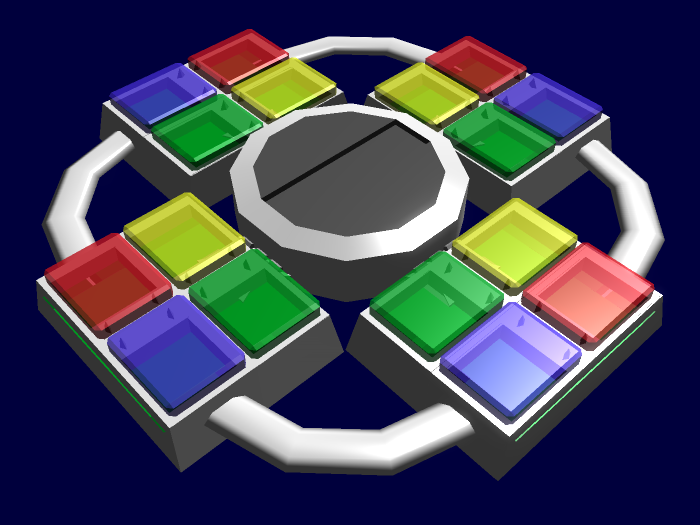Sidebar
Table of Contents
Crystalline Audio Sensor Array
History and Background
Developed in YE 33 by Chusa Kage Yaichiro, the Crystalline Audio Sensor Array was originally intended as an audio detection system for Project THOUGHT devices equipped with the Immersion System, as they were intended to be able to operate in ground engagements. Conventional audio receivers which would function with the clarity and the 3D audio triangulation features desired while not being harmed by space travel or vacuum were traditionally expensive, so something more durable and cost-effective was needed that could sample high fidelity sound for analysis by quantum computers. The design proved to be easy to adjust for various purposes, however, and may easily see proliferation into other devices and systems – including high detail audio recordings and 3D audio.
About the Crystalline Audio Sensor Array
The Crystalline Audio Sensor Array is constructed of sensors each made of one, two, or four artificially constructed crystals. These crystals are designed to pick up different ranges of audio information based on their purpose and configuration, and different numbers of sensors can be used depending on the level of sound quality and processing desired. These artificially constructed crystals are durable, but designed to vibrate at predetermined frequencies of sound, which are recorded as data for processing by a computer.
The Crystalline Audio Sensor Array is intended to function better than a standard microphone, and take advantage of the processing capability of a quantum computer for 3D audio triangulation in the highest classes of arrays.
Types of Crystalline Audio Sensors
Single-crystal
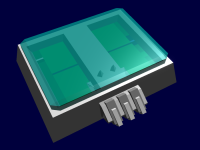 Single-crystal sensors are the simplest of all, and are usually “exclusive detection” crystals or “niche” crystals. Most of these crystals are designed to pick up the frequency band of peoples’ voices, though some are used to detect other bands. In either case, these crystals are designed to relay a specific band of frequencies and not relay outside that band effectively. These are among the cheapest to manufacture and the most compact.
Single-crystal sensors are the simplest of all, and are usually “exclusive detection” crystals or “niche” crystals. Most of these crystals are designed to pick up the frequency band of peoples’ voices, though some are used to detect other bands. In either case, these crystals are designed to relay a specific band of frequencies and not relay outside that band effectively. These are among the cheapest to manufacture and the most compact.
Dual-crystal
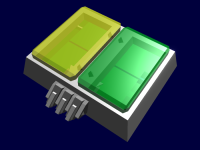 Dual-crystal sensors utilize a high frequency crystal and a low frequency crystal, to cover the entire range of standard humanoid hearing, with a bit of room above and below to spare. This is equivalent to a single high quality microphone, and though it is not quite capable of picking up all the frequencies detectible by the Nekovalkyrja ear, but it comes close enough to allow the enjoyment of music. It is possible to adjust the levels of high frequency and low frequency sound used in output since they are detected independently, emulating quality high pass or low pass filters at a tiny fraction of the cost. These can be seen in civilian systems.
Dual-crystal sensors utilize a high frequency crystal and a low frequency crystal, to cover the entire range of standard humanoid hearing, with a bit of room above and below to spare. This is equivalent to a single high quality microphone, and though it is not quite capable of picking up all the frequencies detectible by the Nekovalkyrja ear, but it comes close enough to allow the enjoyment of music. It is possible to adjust the levels of high frequency and low frequency sound used in output since they are detected independently, emulating quality high pass or low pass filters at a tiny fraction of the cost. These can be seen in civilian systems.
Quad-crystal
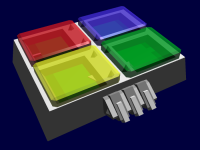 Quad-crystal sensors are an arrangement of very-low frequency, low frequency, high frequency, and very-high frequency crystals. These provide the best samplings of audio, picking up well outside the normal audio range. These crystals are not only able to make a full representation of the audio spectrum, but can be used to selectively distinguish sounds of differing frequencies. These are the highest quality sensors used, and are typically used in systems where the sound is to be processed in some way by a quantum computer. These are the kind intended for military applications, though a few may be seen in high end civilian systems.
Quad-crystal sensors are an arrangement of very-low frequency, low frequency, high frequency, and very-high frequency crystals. These provide the best samplings of audio, picking up well outside the normal audio range. These crystals are not only able to make a full representation of the audio spectrum, but can be used to selectively distinguish sounds of differing frequencies. These are the highest quality sensors used, and are typically used in systems where the sound is to be processed in some way by a quantum computer. These are the kind intended for military applications, though a few may be seen in high end civilian systems.
Classes of Crystalline Audio Sensor Arrays
Monaural Sensor
 Monoaural Sensors, or Mono Sensors, almost always consist of a Single-crystal sensor and produce one channel of sound, and therefore are not a true array by themselves. These sensors are used when triangulation of a sound's spatial coordinates in three dimensions is not in any way important, relegating them to the realm of low end or specialized equipment. Many microphones used solely for verbal communication or for the detection of specific sounds in ultra low or ultra high frequencies are of this type, as they transmit the least data necessary while providing a functional relay of information rather than a representation of the full audio spectrum. Due to this role and low cost, most monoaural sensors have only one specialized crystal in their sensor, made to detect the range of frequencies in which it is intended to see use, though a select few may have a Dual-crystal sensor for higher quality.
Monoaural Sensors, or Mono Sensors, almost always consist of a Single-crystal sensor and produce one channel of sound, and therefore are not a true array by themselves. These sensors are used when triangulation of a sound's spatial coordinates in three dimensions is not in any way important, relegating them to the realm of low end or specialized equipment. Many microphones used solely for verbal communication or for the detection of specific sounds in ultra low or ultra high frequencies are of this type, as they transmit the least data necessary while providing a functional relay of information rather than a representation of the full audio spectrum. Due to this role and low cost, most monoaural sensors have only one specialized crystal in their sensor, made to detect the range of frequencies in which it is intended to see use, though a select few may have a Dual-crystal sensor for higher quality.
A common use for this cheapest of systems is for verbal audio transmission with lower bandwidth (such as for basic communications systems), while less common uses are for detection of a specific and exclusive types of audio data such as that given off by tectonic or volcanic activity. In the later, more than one such Crystalline Audio Sensor would need to be used over fair distances for triangulation, which some would argue is a Polyphonic Array.
Stereo Array
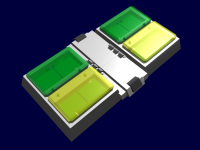 This method creates two complete channels of sound, typically by using Dual-crystal or Quad-crystal sensors. Many commercial devices would use this type, and would use stereo use Dual-crystal sensors for a fair sampling of sound which encompasses the range of the humanoid ear. Devices marketed for Nekovalkyrja may use stereo with Quad-crystal sensors instead, to form a more rich and true sound.
This method creates two complete channels of sound, typically by using Dual-crystal or Quad-crystal sensors. Many commercial devices would use this type, and would use stereo use Dual-crystal sensors for a fair sampling of sound which encompasses the range of the humanoid ear. Devices marketed for Nekovalkyrja may use stereo with Quad-crystal sensors instead, to form a more rich and true sound.
It should be noted that stereo, even when using quad-crystal sensors, cannot easily be calculated in all three dimensions. Due to this, stereo sound is less likely to be utilized in military-grade systems connected to a quantum computer than polyphonic sound is.
Polyphonic Array
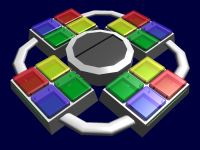 Polyphonic Arrays are, in their most basic definition, more than two sensors of any type. However, the most common polyphonic sensors have Quad-crystal sensors and are in multiples of four. Each sensor makes its own channel of sound, and these channels are typically processed by a quantum computer to provide three dimensional positioning data by analyzing the pitch, tone, and relative volume of the same sounds on different sensors. Once it determines what sounds com from what sources, it is even possible for the computer to selectively amplify or turn down specific sounds.
Polyphonic Arrays are, in their most basic definition, more than two sensors of any type. However, the most common polyphonic sensors have Quad-crystal sensors and are in multiples of four. Each sensor makes its own channel of sound, and these channels are typically processed by a quantum computer to provide three dimensional positioning data by analyzing the pitch, tone, and relative volume of the same sounds on different sensors. Once it determines what sounds com from what sources, it is even possible for the computer to selectively amplify or turn down specific sounds.
The most basic array for calculating 3D sound is a four-sensor cluster, though sometimes in extremely high quality applications, eight are used for precision and redundancy. They can also be used on the frames of craft and vehicles for better sound recording as well as 3D triangulation of the source of weapons fire. This specific array type was initially designed for Project THOUGHT prototypes using the Immersion System.
Page Tools
Terms of Service - Privacy Policy

